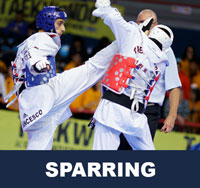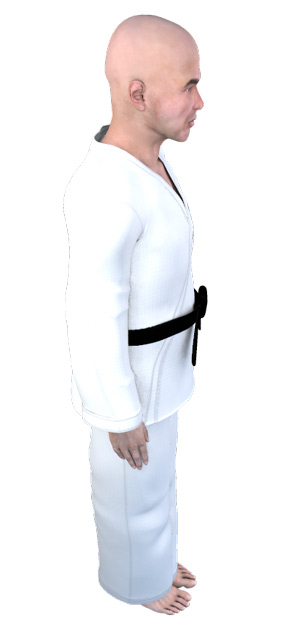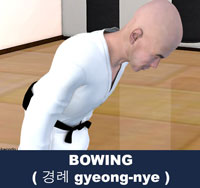Taekwondo 태권도Taekwondo Preschool
Promotion from one geup to the next can proceed rapidly in some schools, since schools often allow geup promotions every two, three, or four months. Students of geup rank learn the most basic techniques first, and then move on to more advanced techniques as they approach first dan. Many of the older and more traditional schools often take longer to allow students to test for higher ranks than newer, more contemporary schools, as they may not have the required testing intervals. View Taekwondo belt levels »
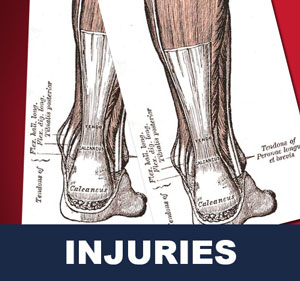
About Pulled Hamstring
Sports injuries are injuries that occur in athletic activities. They can result from acute trauma, or from overuse of a particular body part. Please see a certified specialist or doctor for sports injuries. Proper guidance and instructions are needed from a certified Master Instructor ( 사범님 sabeomnim ) to ensure safe training.
Straining of the hamstring, also known as a pulled hamstring, is defined as an excessive stretch or tear of muscle fibers and related tissues. Hamstring injuries are common in athletes participating in many sports and are very difficult to treat and rehabilitate. Track and field athletes are particularly at risk, as hamstring injuries have been estimated to make up 29% of all injuries in sprinters.
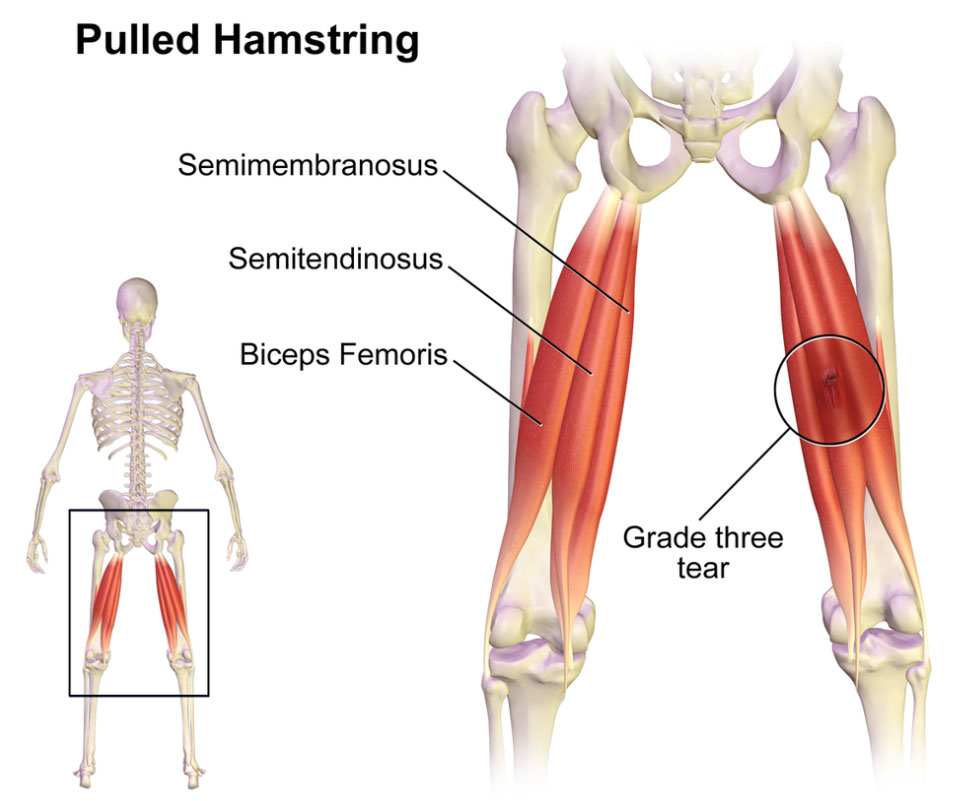
The biceps femoris long head is at the most risk for injury, possibly due to its reduced moment of knee and hip flexion as compared to the medial hamstrings.
The hamstrings undergo a complex dynamic process during gait, making it unsurprising that they are frequently injured. They must first contract concentrically during the end of the stance phase in order to bend the knee and allow the foot (along with dorsiflexion at the ankle) to clear the ground. At the end of the swing phase the hamstrings must eccentrically contract while applying a braking moment to knee extension, and the immediately change functions to again concentrically contract and produce hip extension. Studies have shown that “the hamstring group reaches peak elongation and acts eccentrically at the hip and knee during the late swing phases of running” and that “the hamstrings are most active and develop the greatest torques at the hip and knee during the late swing through midstance phase of running.” Thus, the hamstrings reach their maximum length while attempting to forcefully contract eccentrically and switch functions to immediately produce a concentric contraction, which makes the terminal part of swing phase the most vulnerable for injury.
There have been many other proposed predisposing factors to injury. These include muscle weakness, muscle imbalance, poor flexibility, fatigue, inadequate warm up, poor neuromuscular control, and poor running technique. One of the few predisposing factors that most researchers agree upon however is previous hamstring injury. Brokett et al (2004) stated that “the athletes most at risk of a hamstring strain are those with a previous history of such injury” and noted that 34% of the hamstring injuries were recurrences.” Cameron et al also found that 34% of injuries recur in the same season. Arnason et al generalized these numbers, saying that previous injury was in itself an independent risk factor for re-injury.
Grades
Grade 1 - Sensation of cramp or tightness and a slight feeling of pain when the muscles are stretched or contracted.
Grade 2 - With a grade two hamstring strain there is immediate pain which is more severe than the pain of a grade one injury. It is confirmed by pain on stretch, swelling and contraction of the muscle.
Grade 3 - A grade three hamstring strain is a severe injury. There is an immediate burning or stabbing pain and the individual is unable to walk without pain. The muscle is completely torn and there may be a large lump of muscle tissue above a depression where the tear is.
After a few days with grade two and three injuries a large bruise may appear below the injury site caused by the bleeding within the tissues.
Treatment
Recommended treatment for this injury consists of the RICE protocol - rest, ice, Compression - Use an elastic bandage to avoid swelling, and elevation. The RICE method is primarily used to reduce bleeding and damage within the muscle tissue. Lower grade strains can easily become worse if the hamstring is not rested properly. Grade one hamstrings should be rested from sporting activity for approximately 3 weeks, and grade two injuries typically require 4 to 6 weeks for recovery. Complete ruptures require surgical repair and rehabilitation for approximately 3 months.
Initial treatment of the injury, regardless of the severity of the strain, is the same. Within the first five days, the hamstring is rested in an elevated position with an ice pack applied for twenty minutes every two hours. A compression bandage is applied to limit bleeding and swelling in the tissues. After five days of rest, active rehabilitation begins.
Given that rest is such a crucial factor in recovery, crutches may be necessary for long distance travel. For short distances, crutches are unnecessary, however, use of crutches during travel may prevent worsening the grade of the strain.
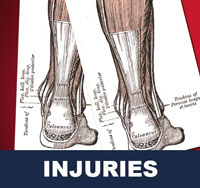
Related Articles
Sports injuries are injuries that occur in athletic activities such as in taekwondo. They can result from acute trauma, or from overuse of a particular body part. Collisions with the ground, objects, and other practitioners are common, and unexpected dynamic forces on limbs and joints can cause injury. View Sport Injuries »
- Achilles Tendon - the Achilles tendon is the most commonly injured tendon. Rupture can occur while performing actions requiring explosive acceleration, such as pushing off or jumping.
- Bone Fracture - a bone fracture is a medical condition in which there is a break in the continuity of the bone. A bone fracture can be the result of high force impact or stress, or a minimal trauma injury as a result of certain medical conditions that weaken the bones, such as osteoporosis, bone cancer, or osteogenesis imperfecta.
- Pulled Hamstring - defined as an excessive stretch or tear of muscle fibers and related tissues. Hamstring injuries are common in athletes participating in many sports and are very difficult to treat and rehabilitate.
- Sprain - damage to one or more ligaments in a joint, often caused by trauma or the joint being taken beyond its functional range of motion. The severity of sprain ranges from a minor injury which resolves in a few days to a major rupture of one or more ligaments requiring surgical fixation and a period of immobilisation.
- Sprained Ankle - also known as an ankle sprain, twisted ankle, rolled ankle, floppy ankle, ankle injury or ankle ligament injury, is a common medical condition where one or more of the ligaments of the ankle is torn or partially torn.
- Strain - an injury to a muscle in which the muscle fibers tear as a result of overstretching. A strain is also colloquially known as a pulled muscle. The equivalent injury to a ligament is a sprain.
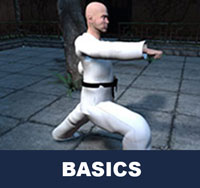
Taekwondo Basics
Here is where you can learn more about Taekwondo 태권도. Knowing the fundamental basics is very important for your learning path as you build your skills and knowledge. There are certain rules that need to be followed to show respect to the master ( 사범님 sabeomnim ), the instructors ( 교사님 gyosannim ), other practitioners and to the martial arts. They vary between schools but many have similar rules and guidelines. For more information View Taekwondo Basics »
Please see a certified specialist or doctor for sports injuries. The article provided on this page is information that is widely available on Wikipedia article "Pulled Hamstring". Risk of injury can be reduced by completing an effective warm up consisting of a heart raiser to get your pulse up, followed by sport specific dynamic stretches (stretches whilst moving). Please follow the guidance of a certified Master Instructor or trainer when doing sports related activities.
RESOURCES
This article uses material from the Wikipedia article "Pulled Hamstring", which is released under the Creative Commons Attribution-Share-Alike License 3.0.



